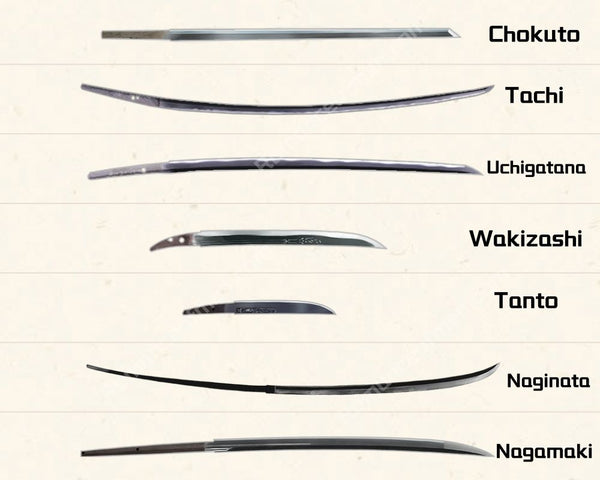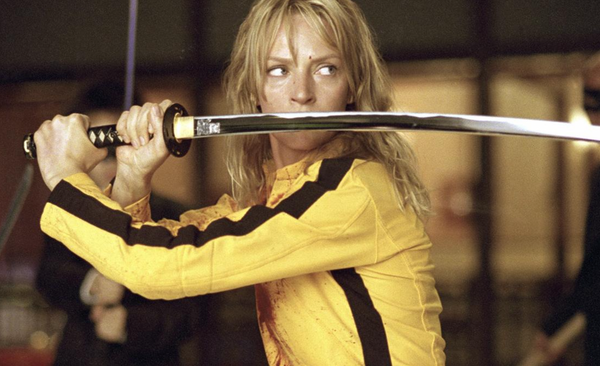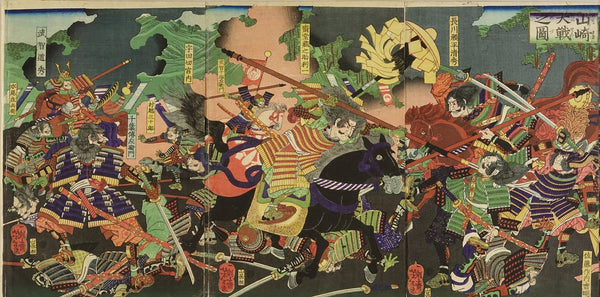Is the Samurai Sword The Best Weapon Of All Time?
Is the Samurai Sword The Best Weapon Of All Time?

Samurai sword Katanas are pretty popular, not only in Japan but also in the whole world, primarily because of their unique and stunning design. Its sharp edges and curvature make the sword one of the deadliest weapons humans can own. Because Katana is so popular, it inevitably becomes a benchmark for comparison, people often ask is katana the best sword? Is katana the strongest? sharpest? With many questions in mind, we will explore these questions and help you understand the katana better.
Table of Content
- Is katana the best sword?
- Is Katana the best weapon on battlefield?
- Is katana the most popular weapon?
- Is katana the sharpest sword?
- Is Katana the strongest sword?
- Is Katana the most beautiful sword?
- Pros and Cos of Katana in battles
- How Does Katana Compare With A Longsword Sword?
- Katana VS Yari: How Does Katana Compare With A Yari (Spear)?
Is katana the best sword?
Yes, we believe the katana is, overall, the best sword.
Calling any sword "The best sword" will inevitably caused an intense debate. Just like another swords, Katana, one of the most revered and iconic swords in history, has its pros and cons. We will break down the advantages and disadvantages of the katana sword. And let you know why we pick Katana, over all types of swords around the world and call it the best.

Noted that, when most people talk about Katana, they are referring to the Uchigatana 打刀. But Katana actually refers to all types of Japanese swords, this article will not bring the topic too board, so we will focus the conversation on Uchigatana or Tachi 太刀.
We evaluated the katana based on four key criteria: practicality, cultural significance and popularity, modern-day use, and aesthetics.
1. Practicality
A great sword must prove its effectiveness in battle, not just as a decorative wall hanger. The katana is a versatile weapon, suitable for both thrusting and cutting. While it doesn’t perform as well as the European longsword against heavily armored enemies, it remains an excellent and reliable weapon.
Rating: 4/5
2. Cultural Significance and Popularity
The katana is deeply connected with Japanese culture, often referred to as the soul of the samurai. As described in The Chrysanthemum and the Sword, the katana represents the assertive, martial aspect of Japanese identity. No other sword embodies a nation’s cultural identity as much as the katana. Additionally, its worldwide popularity is unmatched.
Rating: 5/5
3. Modern-Day Use
While most swords became obsolete with the advent of firearms, the katana has retained its relevance thanks to traditional Japanese martial arts like kenjutsu. It is still widely used today for training, sports, and exercise, maintaining its practicality in the modern world.
Rating: 5/5
4. Aesthetics
Japanese craftsmanship is renowned for blending beauty and functionality, and the katana exemplifies this. Its elegant curved blade, shaped through clay-tempering, is a work of art. The ornate fittings further enhance its aesthetic appeal, making it one of the most decorative and visually striking swords in the world.
Rating: 5/5
For these reasons, we believe the katana stands above all other swords. Its combination of practicality, cultural significance, modern relevance, and aesthetic beauty cements its status as the best sword in history.
Is Katana the best weapon on battlefield?

The answer is no. Surprising as it may be to many, the Katana (uchigatana) was not much used in the large-scale battles in ancient Japan. The available data from Japan's Warring States period shows that the majority of injuries were from arrows (38.6% battle 'wounds'), followed by firearms (22.2%), and spears (20.8%). Stones caused more injuries (11.3%) than uchigatanas that represented in 4.5%. Uchigatana was mainly a symbol of honor and used for ceremonies, martial arts, and self-defense. After the Sword Abolishment Edict, only certain officials could bear katanas. This led to the Satsuma Rebellion where the government got to know how important this katana is and continued using it in the military and police.
Tachi in compare, was used a bit more often than Uchigatana, but in ancient Japan, Yumi (bow), Yari (spear), Naginata, Nagamaki etc, these long range weapons are the main characters in the battlefield. After the firearms (tanegashima guns) were introduced to Japan, Katana became more of a culture symbol rather than a practical weapon.
Is katana the most popular weapon?

Yes, Katana is the most popular weapon. The katana, has indeed become a highly popular weapon in Western pop culture, significantly influenced by its portrayal in various media. One key factor in its rise to fame is its depiction in blockbuster movies and series. For instance, Quentin Tarantino's "Kill Bill" series prominently features the katana in its stylish, action-packed sequences, making it a symbol of coolness and badassery. Additionally, the anime series "Demon Slayer" has gained massive international popularity, with its characters wielding katanas in their battles against demons. This has further cemented the katana's place in popular culture, especially among younger audiences.
Another factor contributing to the katana's popularity is its exotic and mystical appeal, enhanced by its depiction in iconic franchises like "Star Wars." The lightsaber, a weapon in the "Star Wars" universe, draws heavy inspiration from the katana, both in design and the way it's wielded. This blend of traditional martial arts and futuristic technology has captivated audiences worldwide, adding to the katana's allure. While specific data on the katana's popularity in Western pop culture is challenging to quantify, its consistent appearance in influential media and the fervent fan following for these franchises serve as strong indicators of its widespread appeal.
Is katana the sharpest sword?

Yes, Katana is the sharpest sword. Because its design and the cultural emphasis placed on its sharpness. The katana is renowned for its distinctive curved shape, which is optimized for slicing or cutting motions. This design is not just for aesthetic appeal; it's a result of meticulous craftsmanship aimed at creating a blade that excels in sharp, swift cuts. The curvature (Sori) of the katana allows for a more effective angle in cutting, making it incredibly efficient in its intended use, whether on horseback (Tachi) or on foot (uchigatana).
Furthermore, Japan's rich sword-making tradition includes the practice of sword cutting test called (tameshigiri), a system that tests and ranks swords based on their cutting performance. only the best ones can be called "業物" (Wazamono), and the above Wazamono, there are Ryōwazamono (良業物), Ōwazamono (大業物) an Saijō Ōwazamono (最上大業物).
This isn't just a measure of sharpness; it's a comprehensive evaluation of the sword's quality, including its ability to maintain sharpness, its durability, and its overall effectiveness in cutting. Japanese swordsmiths are renowned for their dedication to crafting blades of exceptional quality, with an emphasis on achieving the utmost sharpness.
While it's true that many swords can be honed to a razor-sharp edge, the katana's design, combined with the cultural importance placed on sharpness, makes it most qualified for the title "Sharpest sword".
Is Katana the strongest sword?

Katana is less likely the strongest sword. While it is renowned for its sharpness, the katana, katana is not the strongest in terms of overall durability and versatility. Swords like the longsword claymore are generally stronger.
The katana's design and crafting method were optimized for the specific combat conditions of feudal Japan. Historically, the katana was often used against opponents who were not heavily armored, the ideal weapon to due to Japannese armor is the Yoroidoshi tanto, use to penetrate the gap. Katana's sharp, thin blade was ideal for quick, precise cuts against lightly armored or unarmed targets. Katana wasn't designed to be a robust, strong sword.
There is a differential hardening process in the traditional katana making, the swordsmith coats the blade with a layer of clay, with varying thicknesses along different parts of the blade. When the blade is heated and then quenched, the parts of the blade covered with a thinner layer of clay cool faster and become harder, while the areas with thicker clay cool more slowly and remain relatively softer. This results in a blade with a hard, sharp edge and a more flexible spine (Also this is how hamon is created), enhancing its cutting ability while preventing it from being too brittle. But even this this method, Katana is still not as strong as the European long swords.
Is Katana the most beautiful sword?

Yes, Katana undoubtedly is the most beautiful sword. While most swords around the world are often seen just as weapons for battle, the katana is different. It's more than just a tool for fighting, it's a work of art. The way it's made and what it means culturally lifts it up to something special, not just a piece of metal for war.
Katana strikes you with the cool first impression, but upon closer examination, it's often difficult to pinpoint exactly where the 'beauty' of the Japanese sword lies. Many people recognize that it looks good, but understanding why can be a challenge. This is because the beauty of the Japanese sword is both superficial and profound, both macroscopic and microscopic. If one tries to grasp it all at once, without distinguishing these layers, it becomes difficult to truly appreciate the beauty of the Japanese sword.
Generally speaking, the key points of appreciation for Japanese swords are: 'Sugata' (姿 the overall form), 'Jigane' (地鉄 texture of the blade), and 'Hamon' (刃文 blade pattern) and Koshirae (拵 sword fittins):
-
Sugata (姿 - The Overall Form): This refers to the overall shape and structure of the sword. It includes the curvature, length, width, and other physical dimensions of the blade. The Sugata is crucial as it influences the sword's balance, cutting ability, and aesthetic appeal. Different eras and swordsmiths produced varying Sugata, reflecting the evolving styles and functional requirements of the times.
-
Jigane (地鉄 - Texture of the Blade): Jigane is about the steel's quality and the visible texture on the blade, often resulting from the swordsmith's technique and the folding process of the steel. This texture can give insights into the forging process and quality of the sword. A well-crafted Jigane is admired for its beauty and is a testament to the skill of the swordsmith.
-
Hamon (刃文 - Blade Pattern): The Hamon is the visual pattern along the edge of the blade, created by the differential hardening process. It is not only aesthetically pleasing but also serves a functional purpose, indicating the transition between the harder, sharper edge and the softer, more flexible spine of the blade. The variety in Hamon patterns is immense, and each pattern can be seen as a unique signature of the swordsmith.
-
Koshirae (拵 - Sword Fittings): Koshirae encompasses all the fittings of the sword, including the hilt (Tsuka), handguard (Tsuba), and scabbard (Saya). These elements are not just functional but are also an opportunity for artistic expression. The materials, design, and craftsmanship of the Koshirae can significantly enhance the overall beauty and value of the sword, often reflecting the status and taste of the sword's owner.
Pros and Cos of Katana in battles
Not Good At Blocking
Though Katanas are designed for thrusting, they are not quite good at blocking compared to other swords. It's a sword that needs a certain age to polish and sharpen. And you might not want to damage it too quickly. Otherwise, its immensely sharp edge becomes brittle.
Katanas are famous for cutting but not suitable for dodging or blocking. In fact, you can say that it's in a mediocre position in terms of defence.
Designed Mainly for cutting
Getting an all-around weapon is crucial as a warrior, and Katanas are not one of them. Its perfect curvature is suitable for cutting like draw and cut situations.
However, only cutting is not helpful in battles. In samurai battles, you must use other major weapons like bows, spears, and later matchlocks. Katanas are like expensive status symbols saved for last resort. On top of that, it's a short weapon not designed for defensive battles.
Don't Believe In Myths (Unrealistic cutting power)
Whenever we hear about Katanas, an unchanged sentence comes with it -"Katanas can cut through anything." Well, it's far away from the truth! It's not like a mystical or magical weapon that cuts a human body into half or pierces your armour.
Obviously, Katanas are good at cutting. However, it can't break the laws of physics by slicing metal armour like butter. Such superstitions are only applicable in anime, not in real life.
Too Lengthy Sword-Making Process
Japanese Katanas are not like other swords. It uses metal folding techniques to force the blade, folding various layers of metals into one and heating it to make a single sword. This process takes a longer time than expected. It's very often this takes months to forge a Katana. That means the cost to make a katana will be much higher, and it's financially difficult to equipe the whole army with fine katanas.
How Does Katana Compare With A Longsword Sword?
Longsword is a European sword with a straight blade with a better length. During Renaissance and Medieval periods, people used this sword with colossal effectiveness. Therefore, whenever the "best sword" debate comes in, the longsword sword gets on the list.
Therefore, let's see how the Japanese Katana compares with a European longsword word:
Attacking Ability
The European longsword sword is double-edged, and the Katana is a single-edged weapon. That's why the Katana gets the upper hand in attacking speed. However, longsword blades can offer you a wider variety of techniques. It also allows the users a continuity to threaten their opponent. So, many professionals prefer longsword swords.
Thrusting
Well, both swords are designed for thrusting. But compared to Katana, longword swords have balanced points that help them move more efficiently, and you won't even need any moving issues. You don't get such advantages with Katanas.
Cutting
When it comes to cutting, no sword can compare with the Japanese sword Katanas. Hands down, without a doubt! The reason is much harder steel. Compared to the longsword, it flexes more. On top of that, Katanas have a better sharp edge. Therefore, it utilizes the force you apply to the subjects.
Defence
Hands and forearms are one of the vulnerabilities in sword fighting. Both swords give you a guard at your hand. Both Katana and longsword swords can provide defence from all angles. They are also good at parrying. Therefore, you can say that this is a tie.
Length And Weight
Longword swords come 45 to 50 inches long. And its weight is around 3 to 4 pounds. On the other hand, a Katana is approximately 40 inches long. Its weight is approximately 2.5 to 4 pounds. So, the Katanas are slightly shorter and lighter than the longword swords.
Blade Shape
The blade shape is one of the key differences between longwords and Katanas. We all know that Katanas are famous for their curvature with a single edge. However, longswords are straight blades with double edges. Due to the blade shape, you can move faster with Katanas. But you will be better at thrusting and parrying with the longswords.
Katana VS Yari: How Does Katana Compare With A Yari (Spear)?

You must know that Katanas are not the only ones famous on battlefields during wars. Yari or spears are also deadly weapons to injure your opponents. So, let's see the differences between Yari and Katanas:
Range Advantage
A Yari can be 1.5 or 2 times longer than a Katana. So, it will give you a better range advantage than a Katana. You can easily hit your opponent with a spear, and it's pretty helpful on battlefields because enemies will come from all directions.
And you might not be an expert in close combat. But Katanas are primarily used in close combat.
Easy Training
Training with Katanas has been quite challenging from the early years till now. To fight with the Katana, you must be an expert in sword fighting. And most people don't even know how to hold a katana properly. You won't last long in combat with mediocre sword skills.
But it's easy to train with a Yari. And it takes less time to be a skilled spearman. You can easily fight and win with your opponents, even with your mediocre spear skills.
Thrusting Ability
Both Katana and Yari are made for thrusting ability. However, due to range advantage, spears get a better thrusting ability. However, they are not blocked during combat compared to Katanas. So, the score goes to Katanas.
Majority In Battle Field
War can be won by soldiers, and it's tougher to train your soldiers with swords than Yari. So, very few warriors are skilled swordsmen, and the rest are proficient with different weapons. Spears are pretty common among most warriors. So, the majority score goes to Yari.
Travel Problem
You need to travel with your weapon wearing samurai armor during a war. And individuals keep their weapons close. So, it's tough to travel with a spear compared to Katanas.
Final Words
Japanese Katanas are mainly weapons for samurais. They are proven as a deadly weapon against enemies, without a doubt. However, some people make it the ultimate weapon of all time, which is wrong.
Hopefully, the discussion on whether the samurai sword is the best weapon of all time has covered the answers you need. Therefore, Katanas are a great weapon. But you can't give it the tag "best of all time" because other deadly weapons are still available with great purposes.





















